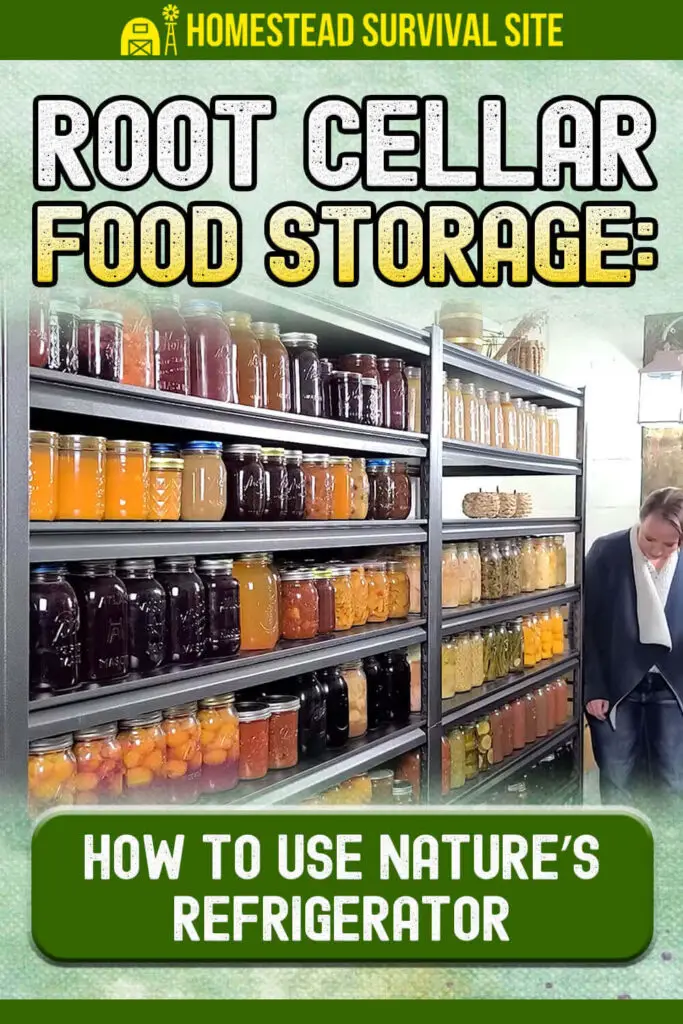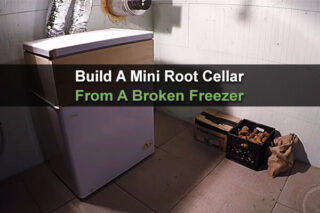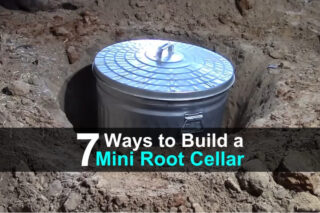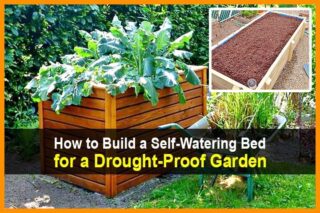Estimated reading time: 9 minutes
Before the invention of refrigerators, root cellars served as a primary method of food preservation. Homesteaders and farmers used root cellars as a way to store turnips, potatoes, beets, carrots, and other root vegetables. Many considered root cellars to be nature's refrigerator.
Today, many still use root cellars as an electricity-free way of storing vegetables and fruit. They've made a comeback as people look for easy ways to save food throughout the year that doesn't require being on the grid.
If you live in an area that has wintry conditions, having a root cellar for food storage makes sense. You can store your homegrown produce or whatever you purchase from the local farmer's market. If the temperatures are low enough, you can even store fermented foods, along with wine, beer, and other homemade beverages.
Want to save this post for later? Click Here to Pin It on Pinterest!
How Does a Root Cellar Work?
A root cellar is any storage location that uses the natural cooling, insulating, and humidifying properties of the earth. Farmers and gardeners use them to store raw and pickled vegetables, relying on the naturally cold temperatures of the ground to keep their food fresh as well.
To work correctly, a root cellar needs three primary conditions. The closer that you come to matching the ideal requirements, the better and longer your veggies will keep.
Root Cellar Ventilation
Air has to come into the root cellar and circulate. It helps to keep the desired temperature and also reduce excess humidity, which can lead to condensation. Also, proper air ventilation removes both vegetable odors and ethylene gas produced by stored fruits.
Remember that warm air rises and cold air falls. So in a root cellar, you need both air intake and an outlet. You want the air intake to below, and the outlet to be high. Ideally, they should be on opposite sides of the room to best circulate the air.
In ideal circumstances, the cool air enters through the low intake ventilation. Warm air rises and releases through the higher outlet.
Root Cellar Humidity
Having high humidity is essential for proper root cellar storage. Most crops need a humidity level of 90-95 percent. The moisture prevents food from drying and spoiling.
Reaching that humidity level can be tricky. Installing a dirt floor helps to retain more natural moisture than concrete or stone, but make sure you spread gravel over the dirt. Gravel helps to keep your feet dry when the ground is too damp.
You can also reach the humidity level by adding water either on the floor or placing pans of water on the cellar floor. Basement root cellars usually need more humidity help than dug-in root cellars. If you can't reach the right humidity level, you can pack the vegetables in damp sawdust, sand, or moss.
There can be a fine line with humidity if the temperature gets too chilly in the root cellar. It can start to condense on the walls or even vegetable surfaces. For that reason, it's best to purchase a hygrometer, a device that measures humidity.
Root Cellar Temperature
The most important consideration is the temperature inside of the root cellar. The ideal temperature is 32-40 degrees F. A range of 40-50 degrees F is acceptable, but it will permit shorter-term storage of root vegetables and apples. You could keep some other veggies like tomatoes and peppers for a month.
To reach temperature stability in an in-ground root cellar, you will need to dig about 10 feet deep.
The Types of Root Cellars
Not all root cellars are the same. You have to decide which one works best for your family.
Basement Root Cellar
Many homes have attached root cellars, especially if you purchased an older home. They allow easy access, but it can take effort to create the right temperature and humidity level.
Here are some tips for creating a basement root cellar.
- Use the foundational walls on the northeast corner as two of the sides of your root cellar. Then, build the other two walls with stud and board.
- Insulate interior walls, ceiling, and door to keep the heat out.
- Create a ventilation system that lets cool air in from the outside and let the stale air out of the cellar to prevent mildew and mold.
The Garbage Can
An innovative way to create a root cellar is with a metal garbage can or a barrel. You can put one of these garbage cans in a hole in the ground to keep water out. The hole needs to be slightly larger than the diameter of the garbage can, and deep enough so the can's lid will sit above the soil level.
Add dirt around the circumference and straw inside of the trash can with the crops. Cover the lid with straw or mulch and a sheet of plastic to keep things dry.
In-Ground Root Cellar
The old-school type of root cellar is an in-ground cellar. It is dug into the ground or horizontally into a hillside. These types of cellars need good drainage, so a sandier soil works the best. If you can create an elevated slope to help the water run away from your pit, it'll be even better.
If your local winter temperatures frequently drop below 25 degrees F, make sure to dig this pit deep enough so that all of the crops are under the soil surface. Line the hole with straw and dried leaves, then cover the hole with a thick, wooden lid.
5 Tips for Creating a Functional Foot Cellar
Temperature is the most essential part of a root cellar, and you need to keep the temperatures low enough that the food doesn't spoil. You want your root cellar to be functional and designed correctly. Here are some tips!
- Add wood shelving, bins, and platforms because wood doesn't conduct heat and cold as metal does.
- Air circulation is vital to reduce airborne mold, so make sure you pull the shelves at least 1-3 inches away from the walls.
- If you can have a packed earth floor, it's ideal for your humidity and temperature. Concrete works for a basement cellar, but it doesn't help with the moisture levels.
- Make sure you have a thermometer and hygrometer and check them frequently.
- Light exposure is the enemy of food storage. In a root cellar, light can cause vegetables to sprout or turn your potatoes green. If you use a window for ventilation, cover it with fabric to stop the light from shining. If you have a light to see inside of the cellar, make sure to turn it off when not in use.
What Foods Can You Store in a Root Cellar?
Not all fruits and vegetables can be stored in a root cellar. It's the perfect environment for raw root crops and some greens, as well as storing jars of pickled veggies and bulbs of perennial flowers.
| Vegetable or Fruit | Average Storage Life in the Right Temperatures | Ideal Storage Temperature, Humidity |
| Apples | 2 to 7 months, depending on the variety | 32-40℉ with 90-95% humidity |
| Beets | 3 to 5 months | 32-40℉ with 90-95% humidity |
| Cabbage | 3 to 4 months, depending on the variety | 32-40℉ with 90-95% humidity |
| Carrots | 4 to 6 months or longer | 32-40℉ with 90-95% humidity |
| Garlic | 5 to 8 months | 50-60℉ with 60-70% humidity |
| Leeks | 3 to 4 months | 32-40℉ with 90-95% humidity |
| Onions | 5 to 8 months | 50-60℉ with 60-70% humidity |
| Parsnips | 1 to 2 months | 32-40℉ with 90-95% humidity |
| Pears | 2 to 3 months | 32-40℉ with 90-95% humidity |
| Potatoes | 4 to 6 months | 32-40℉ with 90-95% humidity |
| Pumpkins | 5 to 6 months | 5 to 6 months of 50-60℉ with 60-70% humidity |
| Rutabagas | 2 to 4 months | 32-40℉ with 90-95% humidity |
| Sweet Potatoes | 4 to 6 months | 50-60℉ with 60-70% humidity |
| Turnips | 4 to 6 months | 32-40℉ with 90-95% humidity |
| Winter Squash | 4 to 6 months | 50-60℉ with 60-70% humidity |
How to Store Food in a Root Cellar
You can have the best root cellar, but your food can still spoil if you don't store food properly in it. Here are some tips for storing food in a root cellar to maximize their shelf life and longevity. Storing food properly also helps to maintain flavor.
- Fill your root cellar as late in the season as you can. If possible, chill the produce in the refrigerator before putting it in the root cellar.
- Some vegetables need to be cured for a few days in warm temperatures before going into long-term storage. Examples of vegetables that need to be cured include winter squash, pumpkins, onions, or potatoes.
- Don't wash the vegetables before storage. All you need to do is shake off the loose dirt. Washing the vegetables means that they might be still wet when they're put into storage, and that puts the food at the risk of rotting.
- Inspect all of the vegetables and fruit that you put into the root cellar. None of them should have bruises, cuts, or any discoloration. The best of your vegetables is what goes into the root cellar. Adding vegetables with cuts in the skin or rotten parts will reduce the shelf life and also reduce how long you can store all of them. Use other storage methods for those fruits and vegetables.
- Since you don't want bruised veggies or fruit in the root cellar, handle the food with care. Don't toss them into the bins. Be gentle.
- Cabbages and turnips need to be stored in a separate location because they have a strong odor.
- Did you know that fruit breathes? Some fruit, particularly peas and apples, need to be wrapped in paper to slow the release of ethylene gas, which can cause other vegetables and fruit to spoil.
- Space out the vegetables. They generate heat when piled together, so make sure any vegetables close to the floor have plenty of space for air circulation.
Root Cellars Are Great for Survival
While canning and dehydrating are fantastic ways to preserve food, they're labor-intensive and require equipment. Root cellars, once created, are the perfect way to store food without too much maintenance naturally.
When we think about survival and homesteading, a root cellar is an addition that will allow you to store your homegrown vegetables and fruit without the need for electricity. Sometimes, low-tech is the best option, even in a modern-day world.
Like this post? Don't Forget to Pin It on Pinterest!













What about a root cellar in the desert? Any ideas?
do you have a book with only the root cellar information without all the adds
too many adds to skip thru and end up having to relocate the areas needed.